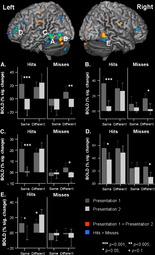Highlight
The Brain Knows What It Knows
Achievement/Results
A team of scientists affiliated with the Center for the Neural Basis of Cognition in Pittsburgh recently showed that changes in brain activation seen in functional MRI (magnetic resonance imaging) scans predict a person’s ability to recognize familiar items in a subsequent memory test. The results suggest that two different types of encoding are being accessed, one conceptual and the other perceptual.
In a paper published in the March 15, 2011 issue of NeuroImage, psychologists Mark Wheeler of the University of Pittsburgh and Lynne Reder of Carnegie Mellon University, their postdoctoral students Anna Manelis and Lisa Storey, and graduate student Christopher Paynter, describe how their experiment revealed correlations between “repetition priming” (showing a stimulus more than once) and recognition memory. Subjects were placed in an fMRI scanner and shown a series of pictures of various types of items, which they were asked to classify as natural (e.g., an apple) or man-made (e.g., an umbrella). Two pictures were presented for each type of item used in the experiment. For half the items, the two pictures were identical, while for the other half they were different (e.g., two distinct umbrellas).
Afterwards, subjects were given a recognition memory test outside the scanner. Subjects were presented with words for various items and asked to judge whether they had seen pictures for that item inside the scanner. If they believed they had seen pictures for the item, they were asked to judge whether the two pictures were the same or different.
The team found significant correlations between neural attenuation in the scanner (that is, a drop in the brain’s activity level for the second presentation of an item compared with the first) and subsequent memory. When two pictures were identical, greater neural attenuation in the brain’s fusiform and inferotemporal cortex aeras was correlated with more accurate recall that the pictures were the same. However, when the two pictures were different, the opposite pattern was found. This shows that subsequent memory effects differ as a function of whether the information being encoded is perceptual (“I’ve seen this picture before”) or conceptual (“I’ve seen this type of item before”).
The work was funded by grants from the National Institutes of Health, and the National Science Foundation’s IGERT (Integrative Graduate Education an Research Training) program.
Address Goals
Studying the mechanisms by which information is encoded and retrieved in the brain will improve our understanding of human learning and memory. Potential applications include improved educational methods, and better diagnosis of memory or learning disorders.






